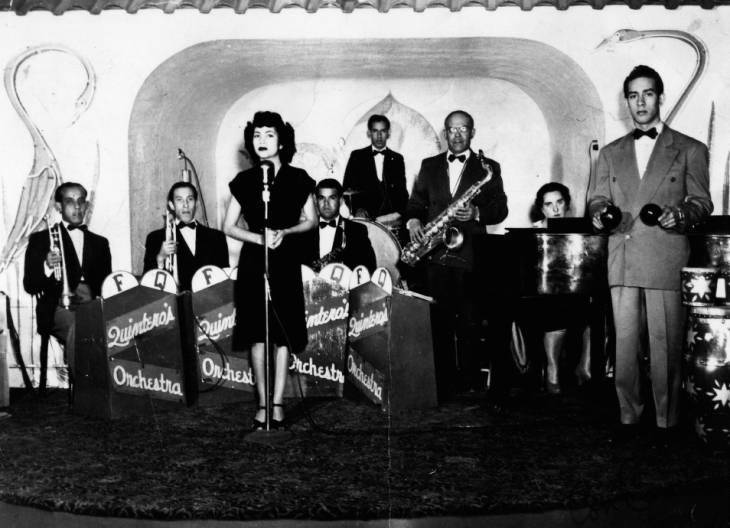
Loteria board at the Arizona History Museum in Tucson. Circa 1870. Paint on tin. Donated by Albert Ruiz. At the time of the donation, Ruiz said the boards belonged to his grandfather, Henri Honore Menager, who ran the Menager clothing store in Tucson.
Did you know that Hispanic Heritage Month is more than fifty years old? It was signed into law as a national week of observance by President Johnson in 1968 and expanded to a full month by President Reagan in 1988. It runs from September 15 to October 15.
Hispanic Heritage Month does two important things: it recognizes and celebrates the contributions of Americans with Spanish, Mexican, Latin, and Central or South American heritage, and it also celebrates the independence days of many countries in Latin America, like Costa Rica, Nicaragua, Mexico, and Chile. Hispanic Heritage Month is sometimes also called Latinx Heritage Month to include people of Latin descent that aren’t from Spanish-speaking countries, like people with Brazilian heritage. According to the US Census Bureau, 60.6 million Americans have Hispanic heritage, so people of Hispanic origin are the nation’s largest ethnic or racial minority. From 2018 to 2019, Maricopa, Arizona had the biggest growth of the Hispanic population in the entire United States.
Arizona has a more than 400-year legacy of Hispanic heritage. From the 1530s until 1821, Arizona and most of the rest of the western United States was claimed by Spain. From 1821 to 1848, the same section of what is now the United States was Mexico. Tucson, most of Southern Arizona, and part of southwestern New Mexico was part of Mexico until 1854. Much of the collection at the Arizona Historical Society is from the 1870s to 1912, a time of great change and negotiation for Mexican people in Arizona. Although Anglo men were a small minority in Arizona before statehood, they increasingly controlled the land, resources, and wealth of the territory. Mexican Arizonans made up the majority of the population of Arizona until the 1920s. Since the 1850s, people in power in what is now Arizona worked to minimize or outright eliminate Mexican history, culture, and heritage. In the 1950s and 1960s, as part of the larger Civil Rights Movement, Mexican people and other Latinx communities agitated for civil rights, including more abstract rights, like the right to know and publicly celebrate the history of their people.
You can explore historic photographs of Mexican Americans in Southern Arizona in the La Herencia del Pueblo: Mexican Heritage Project Photographs online exhibit at the Arizona Memory Project.

This is a photograph of Quintero’s Orchestra at the Baile Hispano-Americano, May 10, 1947. Pictured here are: Mary Lopez (singer), Lalo Robles seated behind her, and Filiberto “Trigger” Quintero Jr. (with maracas). AHS Portrait collection.
Hispanic Heritage Month is also a time to think about people moving around the globe and sharing their ideas and cultures, even in brief stays. While we celebrate and honor our shared history and destiny with Mexico and our Mexican heritage, as Arizonans we encourage you to think about the contributions of other Latinx communities. We remember the legacy of Chilean and Peruvian miners in the California and Arizona gold rush in the 1840s and 1850s. Explore the labor activism of Puerto Rican agricultural laborers brought to Arizona under false pretenses and seek to understand connections to the unfair labor practices against Mexican agricultural workers. Consider the impact of Arizonans on the history of Cuba and the Spanish-American War. We hold space for refugees from Central and South America, who looked to Arizona and the United States as a safe harbor.
Take time to discover, learn, and reflect this month, and throughout the year. For further reading, check out the links below.
On the Web
- https://hispanicheritagemonth.gov/
- https://www.archives.gov/news/topics/hispanic-heritage-month
- https://voces.lib.utexas.edu/
Find a Book
- Christine Marin, “Mexican Americans on the Home Front: Community Organizations in Arizona;
- Tom Sheridan, Los Tucsonense: The Mexican Community in Tucson, 1854-1941, University of Arizona Press
- Eric Meeks, Border Citizens: The Making of Indians, Mexicans, and Anglos in Arizona
- Geraldo Cadava, Standing on Common Ground: The Making of a Sunbelt Borderland
- Lydia Otero, La Calle: Spatial Conflicts and Urban Renewal in a Southwest City, University of Arizona Press
In the Journal of Arizona History
Did you know past issues of The Journal of Arizona HIstory articles are on JSTOR? Sign-Up to receive 100 free articles, or become an AHS Member to receive unlimited free access to past issues of the Journal of Arizona History.
- Manuel G. Gonzales, “Carlos I. Velasco,” Journal of Arizona History, Vol.25, No.3 (Autumn, 1984), pp.265-284.
- Jean Reynolds, “Mexican American Women in 1930s’ Phoenix: Coming of Age During the Great Depression,” Vol. 47, No. 3 (autumn 2006), pp. 213-248.
- James Officer, “Historical Factors in Interethnic Relations in the Community of Tucson,” Arizoniana, Vol. 1, No. 3 (Fall 1960), pp. 12-16.
- Daniel D. Arreola, D. Drew Lucio, Christopher Likinbeal, “Mexican Litchfield Park: A Forgotten Colonia of the Salt River Valley,” Journal of Arizona History, Vol. 49, No. 4 (winter 2008), pp. 329-354.
Contact the Arizona Historical Society
Jaynie Adams
Education Team Lead and Museum Educator
Arizona History Museum, Tucson
Email Jaynie



